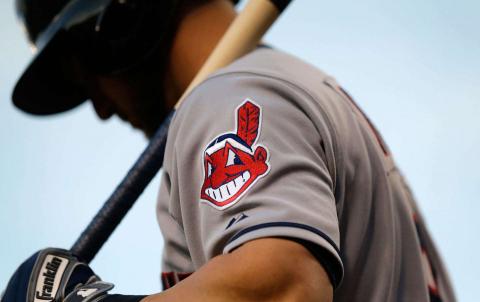It's that time of year: The leaves are changing and the World Series is on. This year, the Cleveland baseball team is playing for its first championship since 1948. It should be a time to celebrate the city, especially in the wake of the NBA’s Cleveland Cavaliers winning a championship in June. Tainting the moment, however, Cleveland’s baseball team comes onto the national stage with the most spectacularly racist logo in professional sports: Chief Wahoo.
Much of the debate over logos and nicknames has been centered around the Washington football team’s racist name (so racist that many publications, including this one, refuse to print it). The logo and name of the Cleveland baseball team has been lost in the shuffle—and team owner Larry Dolan seems keen to keep it that way.
Who is Chief Wahoo? One would think he was created alongside the team, in 1901. In reality, the team changed names frequently in its early days; it was briefly called the Infants, and it wasn’t until 1915 that it settled on the Indians. The origin story is debated, from copying the name of the Boston Braves to “honoring” a former Cleveland baseball player, Louis Sockalexis, who was Native American.
Thirty years later in 1946, the team invented the caricature of Chief Wahoo, a Native American with a red face, a bucktooth smile, and a feather on his head. The blatant racism is cringeworthy. Native Americans just came back from fighting in World War II at a disproportionately high rate, many—popularly called “code talkers”—using their native language to transmit coded secret messages, Ironically, Natives were not legally allowed to speak their language at home.
Dolan, perhaps taking lessons from Dan Snyder’s tin-eared media bumblings when defending the Washington football team, has taken pains to remind fans that he’s no racist owner, all while keeping Chief Wahoo in the lineup.
Dolan has even come out against the name of Snyder’s team, saying, “If we were the Redskins, the day after I owned the team, the name would have been changed.” And yet, earlier this year he said he has no plans to get rid of Chief Wahoo, while also stating that he sympathizes with those who oppose the logo.
This year the team demoted Chief Wahoo from being the “main logo” of the team, trading it in for a large C. You would never know that from watching the team. Chief Wahoo is still featured on the sleeve of the jerseys and on an alternative hat. During the entire American League playoffs the team wore the Chief Wahoo hats every game. Adding insult to injury, some Cleveland fans come dressed up in headdresses and red face to cheer on the “tribe.”
The National Congress of American Indians (NCAI) tried to put the logo in context when it published hats for the “New York Jews” and the “San Francisco Chinamen” with caricatures of each ethnic group next to the hat of the Cleveland Indians.
When the American League Championship series shifted to Toronto, a First Nations activist, Douglas Cardinal, went to Ontario court to bar the logo from being worn while the team played in Toronto, deeming the name and logo to be violations of the Ontario Human Rights code. Major League Baseball and the Cleveland Indians’ front office sent 27 lawyers to challenge this. The judge ruled in favor of Cleveland, but has yet to release his reasons
Olivia Myles, who is Native American and born and raised in Cleveland, said, “Chief Wahoo and other Native American mascots and caricatures are damaging to the spirit and emotional well-being of Indigenous peoples today.” She continued, “Would I like to go to a ballgame? Of course. But it’s a great possibility that some die-hard fan will have their face painted red, with a ridiculous headdress on, swearing up and down that he’s ‘honoring’ us. Seeing that is beyond hurtful.”
Andrew Schriver, a lifelong Cleveland baseball fan said in reference to Chief Wahoo, “It’s a significant embarrassment and something that makes my experience watching baseball worse—like I can’t quite fully root for my home team because every time I see that logo I cringe a little bit.”
He went on to say, “Chief Wahoo is a part of Cleveland history, but so’s the burning river, and I don’t see anyone trying to bring that one back.”
All this is happening as we are seeing exceptional resistance by Native Americans at Standing Rock Indian Reservation to reject the Dakota Access Pipeline. Changing these racist logos, mascots, and names—as the American Indian Movements has asked for five decades—is part of the same fight for Native American justice.
Copyright c 2016 The Nation. Reprinted with permission. May not be reprinted without permission. Distributed by Agence Global.
Please support our journalism. Get a digital subscription to The Nation for just $9.50!


Spread the word